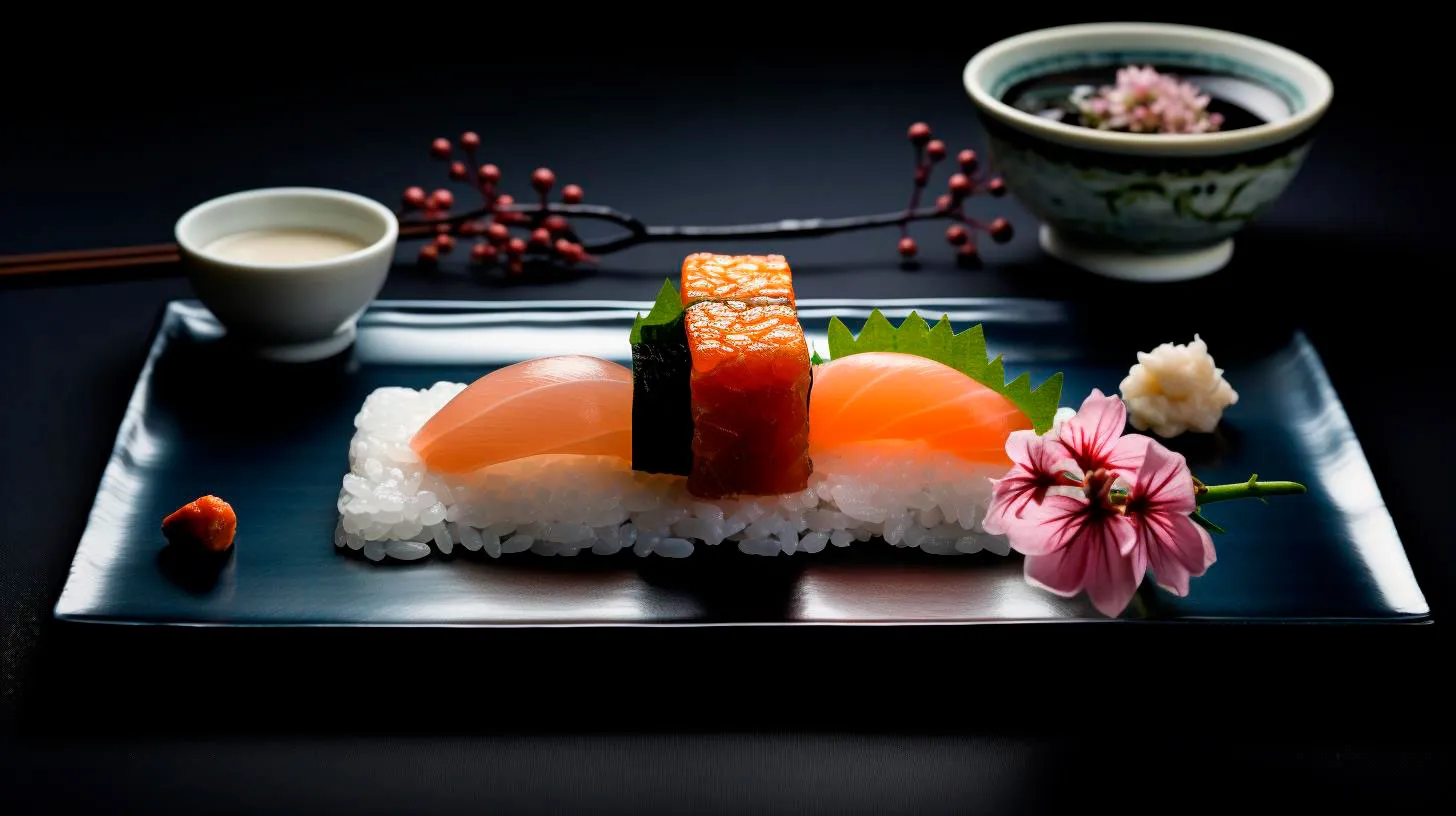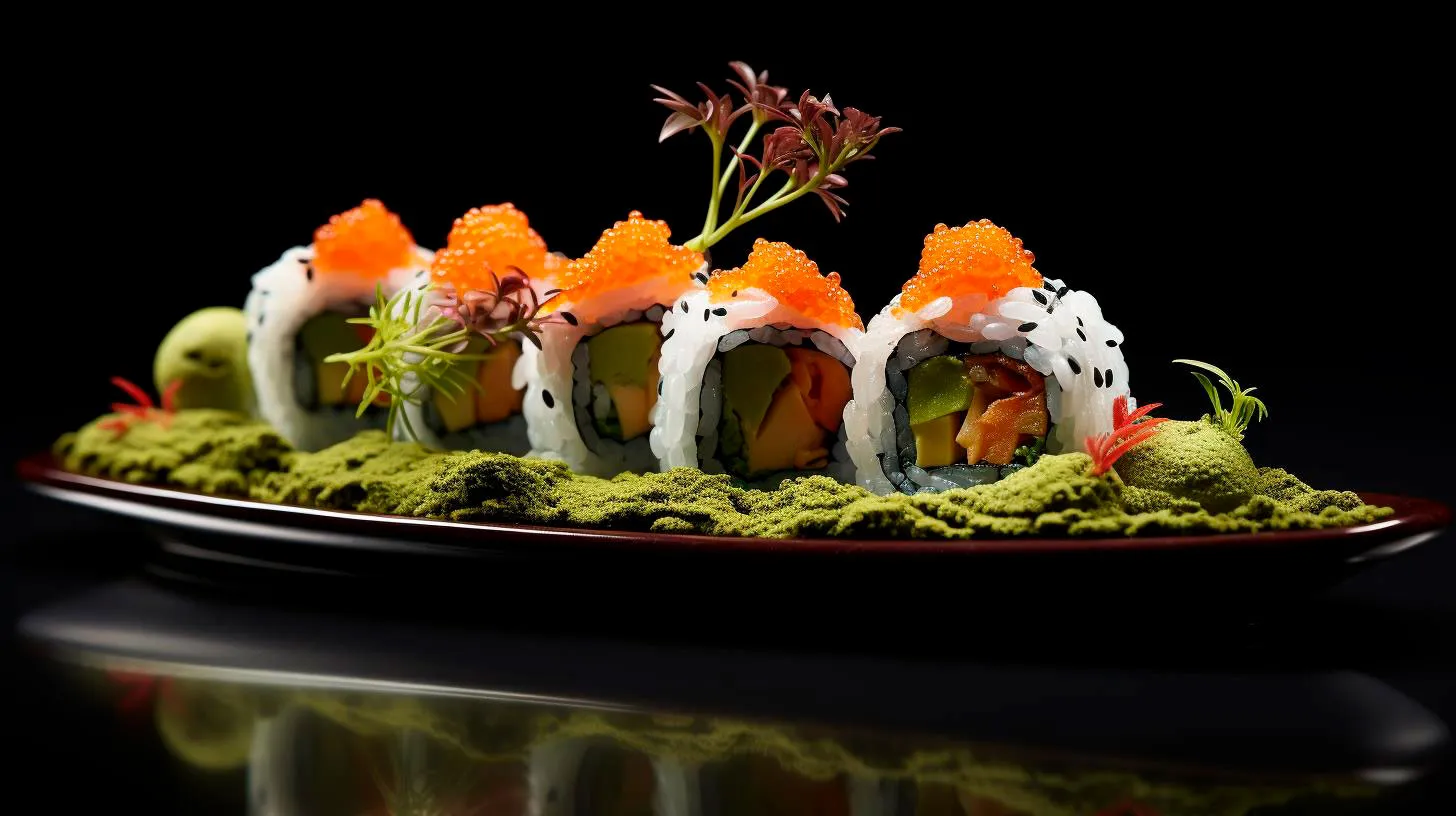The Origins of Sushi: Unveiling its Ancient Secrets
In this article, we will dive deep into the fascinating origins of sushi, unravel its ancient secrets, and explore its evolution over time.
Ancient Roots of Sushi
The story of sushi begins in Southeast Asia, where preserving fish with fermented rice was a common practice. This technique was developed to keep fish edible for longer periods, as refrigeration was non-existent back then. The fermentation process produced a flavorful dish that was both tasty and safe to consume. This early form of sushi laid the foundation for what we know as “nare-zushi” in Japan today.
Over time, sushi making crossed paths with Japan, where it underwent a transformation that would shape its future. The Japanese adapted nare-zushi to their tastes by shortening the fermentation period and consuming the fish along with the rice. This innovation led to the birth of what we now recognize as sushi.
The Rise of Edomae Sushi
During the Edo period in Japan (1603–1868), the sushi we know today began to take shape. Tokyo, known as Edo during that time, played a significant role in sushi’s evolution. The thriving seafood industry in Edo introduced numerous new ingredients and flavors to sushi, elevating it to a whole new level.
One of the key developments of this period was the introduction of vinegar-seasoned rice. Previously, sushi was made with fermented fish and rice, but the use of vinegar imparted a unique tangy flavor to the dish. This transformative step not only improved the taste but also acted as a natural preservative, reducing the fermentation period and making sushi more accessible to all.
Edomae sushi, named after the historical area of Edo, became highly sought after by residents and visitors alike. Street vendors and sushi stalls flourished, offering a wide variety of sushi options. This period witnessed the birth of popular sushi types such as nigiri-zushi (hand-pressed sushi) and maki-zushi (rolled sushi).
Sushi Goes Global
While sushi remained a local delicacy for centuries, it wasn’t until the mid-1900s that it started gaining international recognition. In the aftermath of World War II, sushi chefs from Japan began to migrate to other countries, sharing their culinary expertise and introducing sushi to new audiences.
Initially, sushi faced skepticism and resistance in the Western world due to its raw fish component. However, as people experienced the delicate flavors and fresh ingredients, sushi’s popularity soared. The artistry in sushi presentation, the emphasis on quality and freshness, and the option to cater to various dietary preferences contributed to its international appeal.
Today, sushi has become a global phenomenon with sushi restaurants and takeout options available in nearly every major city worldwide. It has evolved to incorporate modern interpretations and fusion elements, showcasing the adaptability and creativity of chefs around the globe.
Key Takeaways
- Sushi originated in Southeast Asia, where fish was preserved with fermented rice.
- The Japanese innovation of consuming the fish with the rice led to the birth of sushi.
- Vinegar-seasoned rice was introduced during the Edo period, revolutionizing sushi preparation.
- The Edo period also witnessed the development of popular sushi types, such as nigiri-zushi and maki-zushi.
- Sushi gained international recognition after World War II, thanks to Japanese chefs spreading its popularity.
- Sushi’s appeal lies in its fresh ingredients, artful presentation, and ability to cater to diverse dietary preferences.
As we unravel the ancient secrets behind sushi, we gain a deeper appreciation for this culinary masterpiece. From its humble origins to its global status today, sushi represents the harmony of flavors, the art of presentation, and the continuous innovation within the culinary world. So, the next time you indulge in a piece of sushi, savor the taste and reflect on the fascinating journey that brought it to your plate.
Sushi Revolution: How This Japanese Dish Conquered the World
The Origins of Sushi
Sushi originated in Japan around the 8th century, primarily as a means of preserving fish. Back then, fish was wrapped in rice and fermented, allowing it to be stored for long periods. However, this early form of sushi was quite different from what we know today.
It wasn’t until the Edo period in the 19th century that sushi evolved into the delicate and refined cuisine we recognize. During this time, soy sauce, vinegar, and various toppings were introduced, transforming sushi into a harmonious blend of flavors.
Sushi Goes Global
While sushi remained a local delicacy for centuries, its international journey began in the mid-20th century. Credit for this culinary revolution goes to Noritoshi Kanai, the founder of a sushi chain called Sushiro. Kanai introduced the concept of conveyor belt sushi, known as “kaiten sushi,” allowing customers to easily pick their favorite dishes.
This innovation sparked a wave of sushi popularity in Japan, enticing locals and tourists alike. As the world witnessed the fusion of tradition and convenience, sushi became an intriguing culinary experience for food enthusiasts worldwide.
The Rise of Sushi in the West
In the 1960s, sushi made its grand debut in the United States. It initially gained traction among Japanese immigrants and food connoisseurs in major urban areas. However, it wasn’t until the 1980s that sushi exploded in popularity and reached mainstream recognition.
With the emergence of sushi bars and restaurants, Americans quickly developed a taste for this Japanese delicacy. Rolls such as the California Roll, featuring avocado and imitation crab, helped bridge the gap between American and Japanese palates.
The Secrets to Sushi’s Success
So, what makes sushi such a global sensation? Here are some key factors:
- Health Benefits: Sushi is known for its health benefits, with fresh fish providing omega-3 fatty acids, high-quality proteins, and essential vitamins.
- Impeccable Presentation: Sushi chefs often create edible works of art, arranging colorful ingredients with precision. Visual appeal enhances the overall dining experience.
- Varied Options: Sushi offers something for everyone, from raw fish to vegetarian options. With a wide range of fillings and toppings, there’s a sushi roll to suit every taste preference.
- Social and Interactive: The conveyor belt system and communal dining tables in sushi restaurants foster a lively, interactive atmosphere, perfect for socializing and sharing experiences.
Sushi Around the World
The popularity of sushi isn’t confined to Japan or the United States. It has spread its influence globally, captivating taste buds in various corners of the world. Here are some noteworthy statistics:
- According to a report by Statista, sushi sales in the United States amounted to $2.77 billion in 2020.
- Europe embraces sushi as well, with countries like the United Kingdom and Germany experiencing a surge in sushi consumption.
- China, known for its rich culinary heritage, has seen a growing love for sushi, with sushi bars becoming a common sight in major cities.
Key Takeaways
Sushi’s journey from a humble preservation technique to a global sensation is truly remarkable. Its health benefits, impeccable presentation, and varied options have made it an irresistible choice for food lovers around the world. Sushi’s influence has transcended borders, and its popularity only continues to grow.
So, the next time you savor a delicious sushi roll, take a moment to appreciate the intricate flavors and the cultural bridge that this Japanese dish has created. Sushi truly is a revolution that has conquered the world, one bite at a time.
Sushi Rolls: A Creative Gastronomic Journey
In this article, we will take you on a gastronomic journey through the fascinating world of sushi rolls, exploring their diverse styles, unique ingredients, and health benefits.
The Evolution of Sushi Rolls
Sushi rolls, or “makizushi” in Japanese, have come a long way since their inception. Originating in Tokyo in the early 19th century, they were initially simple rolls of preserved fish and rice wrapped in seaweed. However, sushi chefs soon began experimenting with different fillings, seasonings, and preparations, leading to the evolution of sushi rolls as we know them today.
Modern sushi rolls offer a wide range of options, catering to various tastes and dietary restrictions. From vegetarian rolls packed with fresh veggies to decadent rolls filled with seafood delicacies, there is a sushi roll for everyone. Some popular types of sushi rolls include:
- California Roll: A fusion roll made with avocado, crab meat, cucumber, and tobiko (fish roe).
- Dragon Roll: A visually stunning roll that features eel and avocado, topped with thinly sliced avocado.
- Spicy Tuna Roll: A roll for the spice lovers, made with raw tuna and a spicy mayo-based sauce.
- Vegan Roll: A plant-based delight, typically filled with ingredients like cucumber, avocado, and pickled vegetables.
These are just a few examples of the countless variations you can find in sushi rolls, each offering its own unique flavors and combinations.
The Advantages of Sushi Rolls
Sushi rolls not only tantalize your taste buds but also offer several advantages that make them a preferred choice for many. Let’s explore some of these advantages:
1. Health Benefits:
Sushi rolls are often regarded as a healthy food choice. Here’s why:
- Rich in Omega-3 Fatty Acids: Fish used in sushi rolls, such as salmon and tuna, are excellent sources of heart-healthy omega-3 fatty acids.
- Fresh Ingredients: Sushi rolls are typically made with fresh and high-quality ingredients, including vegetables and seafood, providing essential nutrients.
- Low in Fat: Sushi rolls are generally low in saturated fats, making them a healthier alternative to many other dishes.
2. Creative and Aesthetic Appeal:
The art of sushi-making goes beyond taste; it’s also about presentation. Sushi rolls are meticulously crafted, creating visually stunning pieces of edible artwork. Their vibrant colors and intricate designs make them a feast for the eyes, enhancing the overall culinary experience.
3. Versatility:
Sushi rolls are incredibly versatile, catering to various dietary preferences and restrictions. Whether you are a meat lover, vegetarian, or vegan, you can find a sushi roll tailored to your tastes. With the option to customize fillings and toppings, sushi rolls offer endless possibilities for flavor combinations.
Key Takeaways
Sushi rolls have evolved from simple wraps of rice and fish to artistic creations that cater to diverse palates. Here are the key takeaways from our gastronomic journey:
- Sushi rolls have a rich history and continue to evolve with innovative preparations and ingredients.
- There is a wide variety of sushi rolls available, showcasing unique flavors and combinations.
- Sushi rolls offer various health benefits, including omega-3 fatty acids and fresh, nutrient-rich ingredients.
- The aesthetic appeal of sushi rolls adds to the overall dining experience.
- Sushi rolls are versatile and customizable, making them suitable for different dietary preferences and restrictions.
So, next time you crave a taste of Japan, dive into the world of sushi rolls and embark on a gastronomic adventure that is not only delicious but also offers an artistic feast for the senses.
The Health Benefits of Sushi Nutritional Secrets Revealed
A Nutritional Powerhouse
Sushi is more than just a tasty dish; it is a nutritional powerhouse packed with essential vitamins and minerals. Here are some key nutrients found in sushi:
- Omega-3 Fatty Acids: Sushi, particularly those made with fatty fish like salmon and tuna, are an excellent source of omega-3 fatty acids. These healthy fats are known for their role in improving heart health, reducing inflammation, and supporting brain function.
- Protein: Sushi is rich in high-quality protein, thanks to the fish and seafood it contains. Protein is essential for building and repairing tissues, maintaining muscle mass, and supporting a healthy immune system.
- Iodine: Seaweed, a common ingredient in sushi rolls, is a fantastic source of iodine. Iodine is vital for thyroid function, which regulates metabolism and helps promote a healthy weight.
- Vitamins and Minerals: Sushi fills your plate with a variety of vitamins and minerals like vitamin A, vitamin C, folate, calcium, and iron. These nutrients play crucial roles in maintaining overall health and well-being.
Health Benefits of Sushi
The combination of nutrient-rich ingredients in sushi provides numerous health benefits. Let’s take a closer look at how sushi can positively impact your well-being:
1. Heart Health
Sushi, particularly those with fatty fish like salmon and mackerel, are rich in omega-3 fatty acids. Research has shown that consuming omega-3s helps reduce the risk of heart disease. Omega-3s have been found to lower blood pressure, reduce triglyceride levels, and prevent the formation of blood clots.
2. Brain Function
The omega-3 fatty acids found in sushi are not only good for the heart but also for the brain. These healthy fats have been linked to improved cognitive function, memory retention, and a reduced risk of neurodegenerative diseases such as Alzheimer’s.
3. Weight Management
With its low-calorie and high-protein content, sushi can be a great addition to a weight management plan. Protein helps you feel full, reducing hunger cravings and preventing overeating. Choosing lean fish options can further boost the weight management benefits of sushi.
4. Boosted Immunity
The combination of essential vitamins and minerals found in sushi supports a healthy immune system. Vitamin C, in particular, strengthens the immune system and helps defend against common illnesses such as colds and flu.
Key Takeaways
As you can see, sushi offers a range of health benefits, making it a smart choice for those seeking a nutritious and delicious meal. Here are the key takeaways to remember:
- Sushi is rich in omega-3 fatty acids, providing numerous benefits for heart and brain health.
- Protein in sushi supports muscle growth, tissue repair, and a healthy immune system.
- Iodine from seaweed helps maintain thyroid function and metabolism.
- Sushi is packed with essential vitamins and minerals that promote overall well-being.
- Choosing lean fish options can help with weight management.
Next time you’re craving a flavorful and healthy meal, indulge in some sushi. Your taste buds and your body will thank you!



